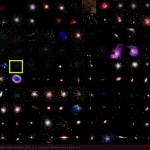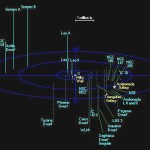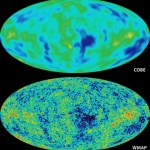background
"A sister is both your mirror - and your opposite." -Elizabeth Fishel
With 110 deep-sky wonders to choose from in the Messier catalogue, our long-running series on Messier Monday promises to keep us busy for some time to come! As we've finally passed the winter solstice here in the Northern Hemisphere, many new spectacular sights await skygazers in the early part of the night. As it's also the 1-year anniversary of when we adopted a little sister for our dog from the local humane society, I thought it would only be fitting to highlight the little sister to last week's Messier object.…
Some of you who've been following astronomy for awhile might remember this report, where a group of astronomers reported finding a giant "void" in the Universe.
What is a void? Well, galaxies are distributed pretty randomly, but because of gravity, they cluster together. A small example is our local group which looks like this,
and a larger example is the Virgo cluster, which is about 1,000 times as massive as our local group, and looks like this:
Well, a void is the opposite of a cluster, where you have a large volume of space that's simply empty of galaxies and matter. This press release…
When I think of molecules, I think of Conan O'Brien doing his skit where he plays Moleculo...
the molecular man! I don't think of astronomy, and I certainly don't think of the leftover radiation from the big bang (known as the cosmic microwave background)! But somebody over at the European Southern Observatory put these two together and made an incredibly tasty science sandwich.
See, we can measure the cosmic microwave background today, because we have photons (particles of light) coming at us in all directions at all locations, with a temperature of 2.725 Kelvin. Theoretical cosmology…
The cosmic microwave background is the radiation left over from the big bang. It's very uniform, 2.725 Kelvin everywhere. We're moving with respect to it, so there's a doppler shift, and we see that as a dipole moment in the Temperature. When we subtract that out, we see variations on the order of 30 microKelvins! WMAP is a satellite (Wilkinson Microwave Anisotropy Probe) that measured these anisotropies, and they just released its year 5 data. First off, with the uniform and dipole parts subtracted out, and with the foreground from the galaxy also taken out, here's the map of the microwave…



